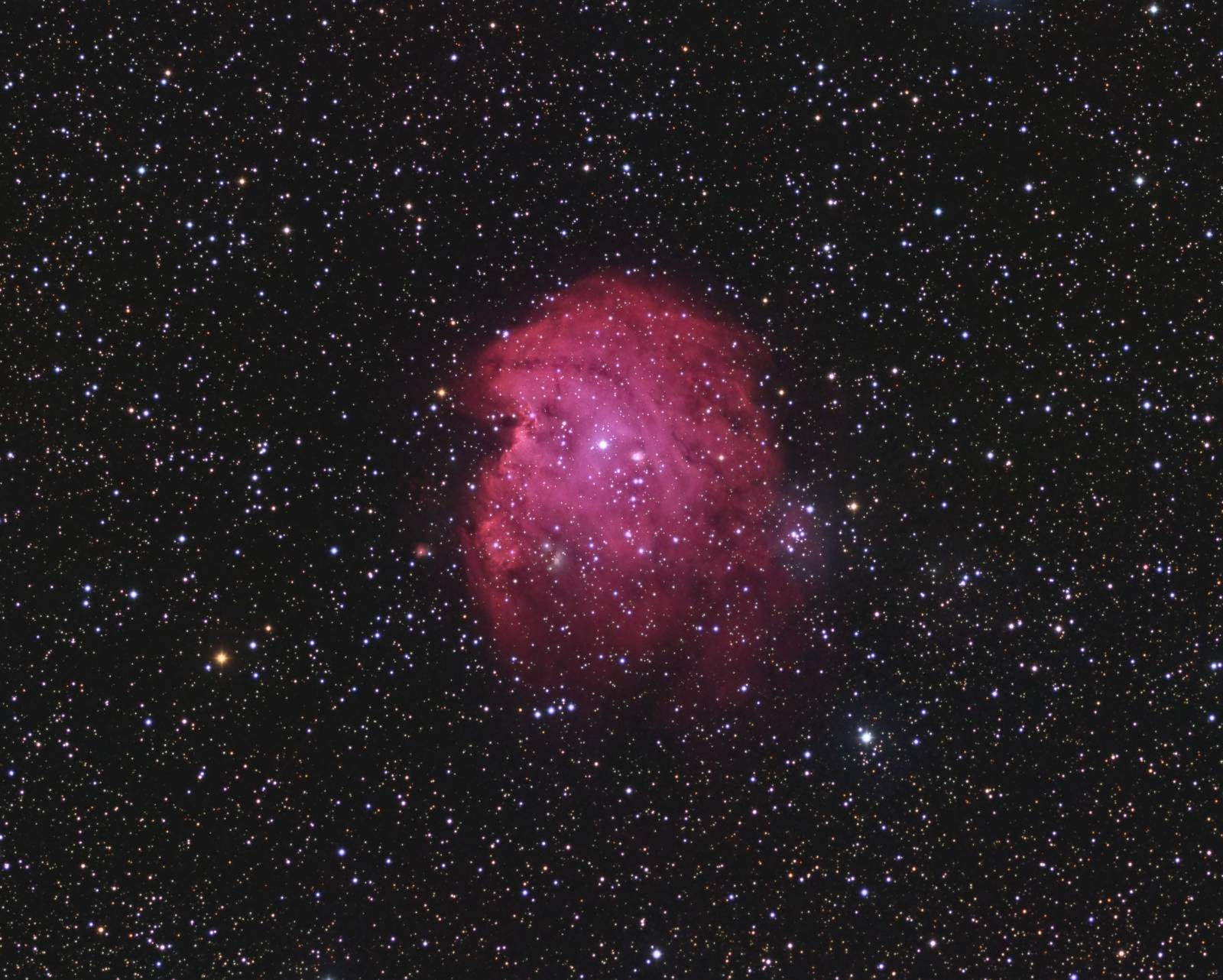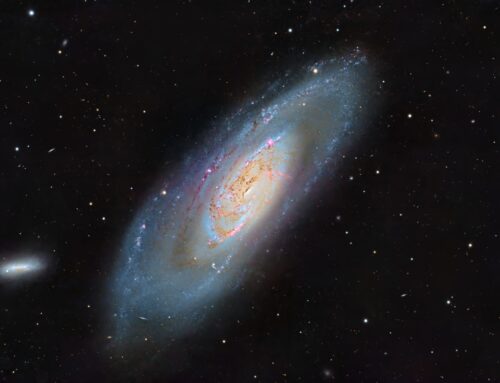Monkey Head Nebula
 Click image for full size version
Click image for full size version
April 15, 2018
The Monkey Head Nebula (NGC 2174; Sh2-252) surrounds open star cluster NGC 2175 and lies about 6,400-7,200 light years from us. The nebula is a stellar nursery, where new stars are forming. In addition to the reddish emission nebula, it contains bluish reflection components. One is at lower right of the nebula, and another is around the brightest star inside the nebula. This field is located in the northern part of Orion, just below the feet of Gemini. Being set in the winter Milky Way, the image is full of stars that show a range of colours varying from orange-red to blue-white based on their temperature (blue is hottest; red coolest).
A previous image of this object that I took with different equipment was Astronomy Magazine’s Online Picture of the Day May 5, 2016.
Tekkies:
Moravian G3-16200 EC camera, Optolong Ha, R, G and B filters, Takahashi FSQ-106 ED IV at f/3.6, Paramount MX. QHY5 guide camera on 175mm guide scope. Acquisition with the SkyX, focused with FocusMax, scripted with CCD Commander. All pre-processing and processing in PixInsight. Acquired from my SkyShed in Guelph. No moonlight, average or better transparency, average seeing. Acquired March 30-April 11, 2018.
5x10m R, G, and B and 15x10m Ha unbinned frames (total= 5hr).
RGB:
Creation and cleanup: The BatchPreProcessing script was used to perform calibration, cosmetic correction and registration of all frames. LocalNormalization, ImageIntegration and DrizzleIntegration were used to create Ha, R, G and B masters. These were each processed with DynamicBackgroundExtraction and then the R, G and B channels were combined with ChannelCombination. PhotometricColorCalibration was applied to the resulting RGB image. The individual colour and Ha masters were saved for use in making the SynthL (see below).
Linear Noise Reduction: MultiscaleLinearTransform was used to reduce noise in the RGB image. Layer settings for threshold and strength: Layer 1: 3.0 0.8 Layer 2: 2.5, 0.7 Layer 3: 2., 0.6.
Stretching: ArcsinhStretch was used to slightly stretch the image, setting the black point so as to avoid any clipping. HistogramTransformation was applied to make a pleasing, bright image. CurvesTransformation was applied to boost contrast and saturation slightly, using a mask to protect the background.
Repair Star Colours: The RepairedHSVSeparation script was used to repair chrominance artifacts in the stars. This was done by running the script and using ChannelCombination in HSV mode to combine the repaired H and S components with the unrepaired V component. The resulting image became the final RGB image.
Synthetic Luminance:
Creation and cleanup of SynthL: The R, G and B channel masters were integrated (average, noise weighted, no rejection) using ImageIntegration to create the SynthL.
Deconvolution: A star mask was made to use as a Local Deringing Support image. A copy of the image was stretched to use as a range mask. Deconvolution was applied (50 iterations, regularized Richardson-Lucy, external PSF made using DynamicPSF tool with about 30 stars).
Linear Noise Reduction: MultiscaleLinearTransform was used to reduce noise in the background areas of the SynthL. Layer settings for threshold and strength: Layer 1: 3.0 0.75 Layer 2: 2.0, 0.6 Layer 3: 1.0, 0.3.
Stretching: HistogramTransformation was applied to the SynthL to make a pleasing, bright image.
Noise Reduction and Re-Stretch: TGVDenoise was applied in L*a*b* mode with 300 iterations with a range mask applied to protect high signal areas. This was followed by a HistogramTransformation to raise the black point (but with no clipping). Dark pixels were brightened slightly using the PixelMath expression
iif($T<0.085, $T+0.5*(median($T)-$T), $T)
H-alpha:
Deconvolution: A star mask was made to use as a Local Deringing Support image. A copy of the image was stretched to use as a range mask. Deconvolution was applied (50 iterations, regularized Richardson-Lucy, external PSF made using DynamicPSF tool with about 20 stars).
Linear Noise Reduction: MultiscaleLinearTransform was used to reduce noise in the background areas of the Ha image. Layer settings for threshold and strength: Layer 1: 3.0 0.75 Layer 2: 2.0, 0.6 Layer 3: 1.0, 0.3.
Stretching: HistogramTransformation was applied to the Ha to make a pleasing, bright image.
Noise Reduction and Re-Stretch: TGVDenoise was applied in Lab mode with 300 iterations with a range mask applied to protect high signal areas. This was followed by a HistogramTransformation to raise the black point (but with no clipping).
Combining SynthL, RGB and Ha:
SynthLRGB: The processed SynthL was applied to the RGB image using LRGBCombine.
SynthLHaRGB: Ha was added to the red and blue channels of the SynthLRGB image using the following PixelMath expression with rescaling off:
R: iif($T<Ha, 0.2*$T + 0.8*Ha, $T)
G: $T
B: iif($T<Ha, $T + 0.1*Ha, $T)
Additional Processing:
Sharpening: Using a mask to protect stars, background and dim nebulosity, MultiscaleLinearTransform was applied to sharpen layers 2 and 3 (bias of 0.1 for both).
Final Steps: Background, nebula and star brightness, contrast and saturation were adjusted in several iterations using Curves with masks as required. The blue areas from the RGB image were used to target a slight increase in blue in specific areas of the nebula.
Image scale is about 1.6 arcsec per pixel for this camera/telescope combination with Drizzle integration.






Beautiful stuff, man.
Thanks!